Intuitionistic Connection Cloud Model Based on Rough Set for Evaluation of the Shrinkage–Swelling of Untreated and Lime-Treated Expansive Clays
Abstract
:1. Introduction
2. Theory
2.1. Intuitionistic Fuzzy Set
2.2. Intuitionistic Connection Cloud Model
- (1)
- Initialization of numbers of cloud drops and the lower limitations of the possible values of the membership degree and non-membership degree corresponding to Ex.
- (2)
- Generation of random numbers En′ from the normal distribution with entropy En and hyper entropy He.
- (3)
- Generation of random numbers xm satisfying the normal distribution of expectation Ex and standard deviation En′.
- (4)
- Generation of random numbers β following the uniform distribution of lower limitation u and upper limitation 1 − v.
- (5)
- Specification of the intuitionistic connection degree of cloud drops through Equation (4). A corresponding drop is obtained as (xm, z(xm)).
- (6)
- Repeat 2 to 5 steps until all cloud drops are obtained.
3. Evaluation Model Based on Intuitionistic Connection Cloud Model
Basic Principle and Evaluation Process
4. Materials and Results
4.1. Data and Model Implementation
4.2. Results and Comparison
5. Discussion
5.1. Description of Interval-Valued Index
5.2. Superiority of the Proposed Model
- (1)
- Compared with the normal cloud model, the intuitionistic connection cloud model offers a useful basis for the depiction of the certain and uncertain relationships between the interval-valued indexes with classification standards from three perspectives, namely, identity, discrepancy, and contrary aspects. Additionally, it overcomes the disadvantage of the requirement of normal distribution.
- (2)
- The proposed model without information loss or distortion can simultaneously express ambiguity, randomness, and hesitation; so, it has the capability to depict high uncertainty in the evaluation of the shrinkage–swelling grade of untreated and lime-treated expansive clays, enhancing the description of the evaluation result “not one is not the other”.
- (3)
- The weights assigned according to the conditional information entropy method based on the rough set can effectively find the index importance. This weighting method can not only avoid prior knowledge and a large number of data requirements but also reduce the errors caused by human factors.
6. Conclusions
- (1)
- The case study indicates that the intuitionistic connection cloud model used to evaluate the shrinkage–swelling grade is effective and feasible. And it can not only reflect the conversion situation at the classification threshold but also capture the hesitation characteristics at the evaluation interval, especially the central expectation point. The intuitionistic connection cloud model can depict hesitant characteristics of the fuzzy and random index, and the results obtained from the proposed model without valid information loss or distortion are more accurate and reliable relative to those of the traditional cloud models.
- (2)
- The weighting method based on conditional information entropy and the rough set greatly reduces the subjective deviation. It not only overcomes the problem of the weight of a few indexes potentially taking 0 or being unable to be assigned via the traditional objective weighting method but also considers the importance of indicators.
- (3)
- Different from the method of taking the mean value of traditional cloud models, the model proposed here expresses the measured value with an interval and determines the membership interval of the sample according to its reliability to replace the confidence level interval artificially determined in the intuitionistic normal cloud. So, the proposed model can explore the true characteristics of the original data to the greatest extent and promote an evaluation process and a final result closer to reality.
Author Contributions
Funding
Institutional Review Board Statement
Informed Consent Statement
Data Availability Statement
Acknowledgments
Conflicts of Interest
References
- Puppala, A.J.; Manosuthikij, T.; Chittoori, B.C.S. Swell and shrinkage characterizations of unsaturated expansive clays from Texas. Eng. Geol. 2013, 164, 187–194. [Google Scholar] [CrossRef]
- Wang, M.W.; Li, J.; Ge, S.; Li, S.T. Moisture migration tests on unsaturated expansive clays in Hefei, China. Appl. Clay Sci. 2013, 79, 30–35. [Google Scholar] [CrossRef]
- Wang, M.W.; Jin, J.L.; Li, L. Application of extension method to the evaluation of the grade of shrinkage and expansion for the expansive soil. Chin. J. Geotech. Eng. 2003, 25, 754–757. [Google Scholar]
- Liu, Y.; Huang, Q.; Hu, C. Classification of expansive soil based on fuzzy information optimization disposal. J. Chang. Univ. Nat. Sci. Ed. 2005, 25, 15–19. [Google Scholar]
- Li, Y.; Feng, X.; Yan, Y. Application of gray clustering procedure to classification of expansive soils. Rock Soil Mech. 2003, 24, 304–306. [Google Scholar]
- Li, J.; Xu, P.; Qin, S.; Wang, M. Classification model for shrinkage-swelling of expansive clay and improved expansive clay. J. Hefei Univ. Technol. (Nat. Sci.) 2013, 36, 969–973. [Google Scholar]
- Liu, S.X.; Wei, W.; Shi, Z.G. Application of BP network in discrimination and classification of expansive soil. J. Liaoning Tech. Univ. 2004, 23, 782–784. [Google Scholar]
- Shi, X.C.; Guo, Z.T. Multi-classification method of GA-SVM on identifying grade of expansive soils. J. Civ. Archit. Environ. Eng. 2009, 31, 44–48. [Google Scholar]
- Wang, M.; Chen, G. A novel coupling model for risk analysis of swell and shrinkage of expansive soils. Comput. Math. Appl. 2011, 62, 2854–2861. [Google Scholar] [CrossRef]
- Wang, M.; Li, J.; Xu, P.; Zhao, K. Cloud model for shrinkage-welling property classification of untreated and lime-treated expansive clays. J. Southeast Univ. 2014, 44, 396–400. [Google Scholar]
- Wang, M.; Wang, X.; Liu, Q.; Jin, J. A novel multi-dimensional cloud model coupled with connection numbers theory for evaluation of slope stability. Appl. Math. Model. 2020, 77, 426–438. [Google Scholar] [CrossRef]
- Du, P.; Chen, Z.; Gong, X. Load response potential evaluation for distribution networks: A hybrid decision-making model with intuitionistic normal cloud and unknown weight information. Energy 2020, 192, 116673. [Google Scholar] [CrossRef]
- Huang, G.; Xiao, L. Failure mode and effect analysis: An interval-valued intuitionistic fuzzy cloud theory-based method. Appl. Soft Comput. 2021, 98, 106834. [Google Scholar] [CrossRef]
- Chen, Y.H.; Huang, G. Improved method of determining comprehensive weight based on rough set theory and AHP. Meas. Control Technol. 2017, 36, 132–135+141. [Google Scholar]
- Atanassov, K.T. Intuitionistic fuzzy sets. Fuzzy Sets Syst. 1986, 20, 87–96. [Google Scholar] [CrossRef]
- Wang, M.; Zhao, K.; Zhang, L. A novel evaluation model based on connectional expectation for swelling-shrinkage grade of untreated and treated expansive clay. Chin. J. Geotech. Eng. 2014, 36, 1553–1557. [Google Scholar]
- GB/50112; Technical Code for Building in Expansive Soil Regions. China Architecture and Building Press: Beijing, China, 2013. (In Chinese)
- Lu, Y.; Wang, D.; Liu, D.; Wang, Y. Water quality evaluation method using improved rough set-cloud model. J. Nanjing Univ. (Nat. Sci.) 2017, 53, 879–886. [Google Scholar]
- Wang, J.Q.; Yang, W.E. Multiple criteria group decision making method based on intuitionistic normal cloud by Monte Carlo simulation. Syst. Eng. Theory Pract. 2013, 33, 2859–2865. [Google Scholar]
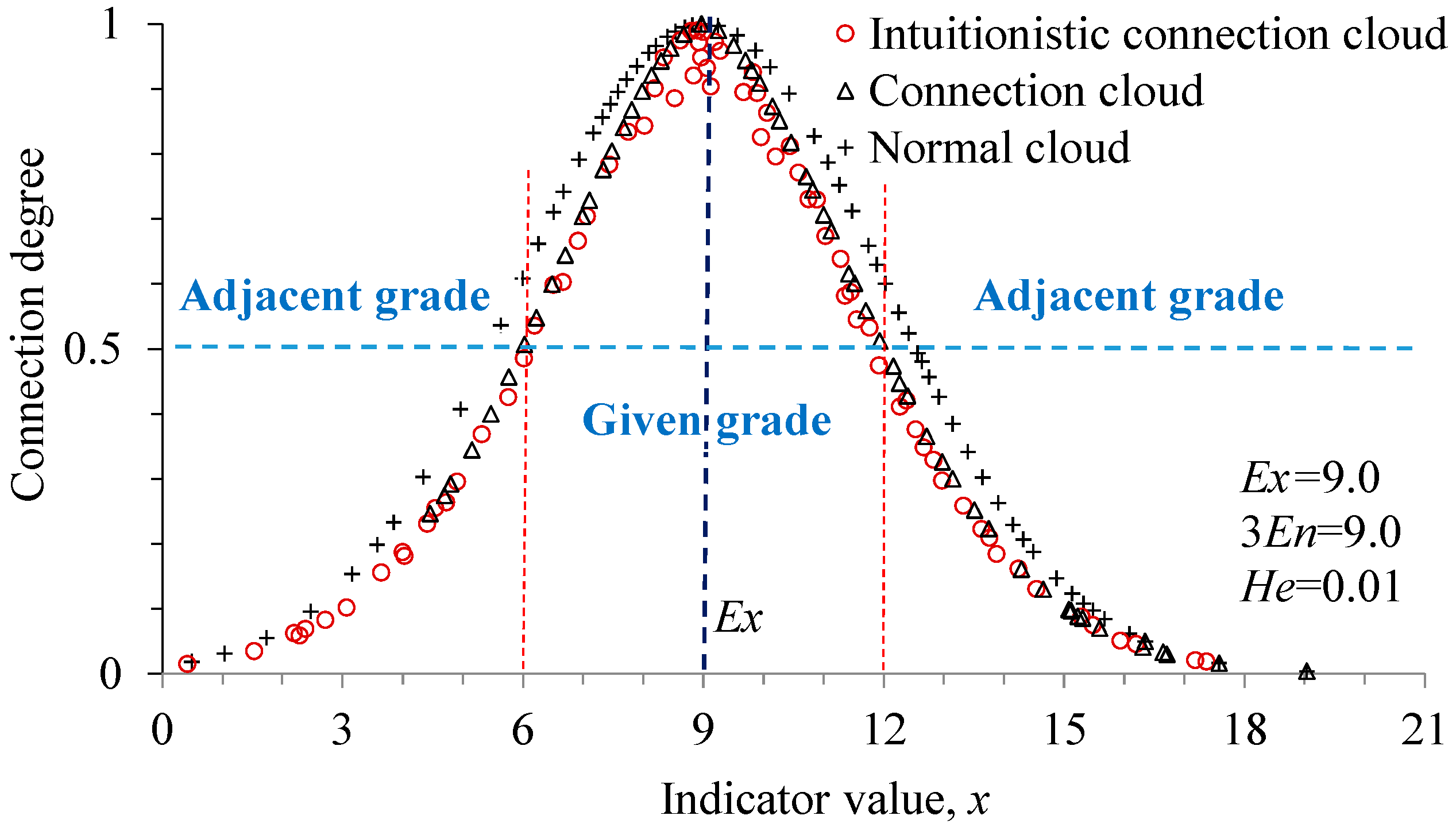
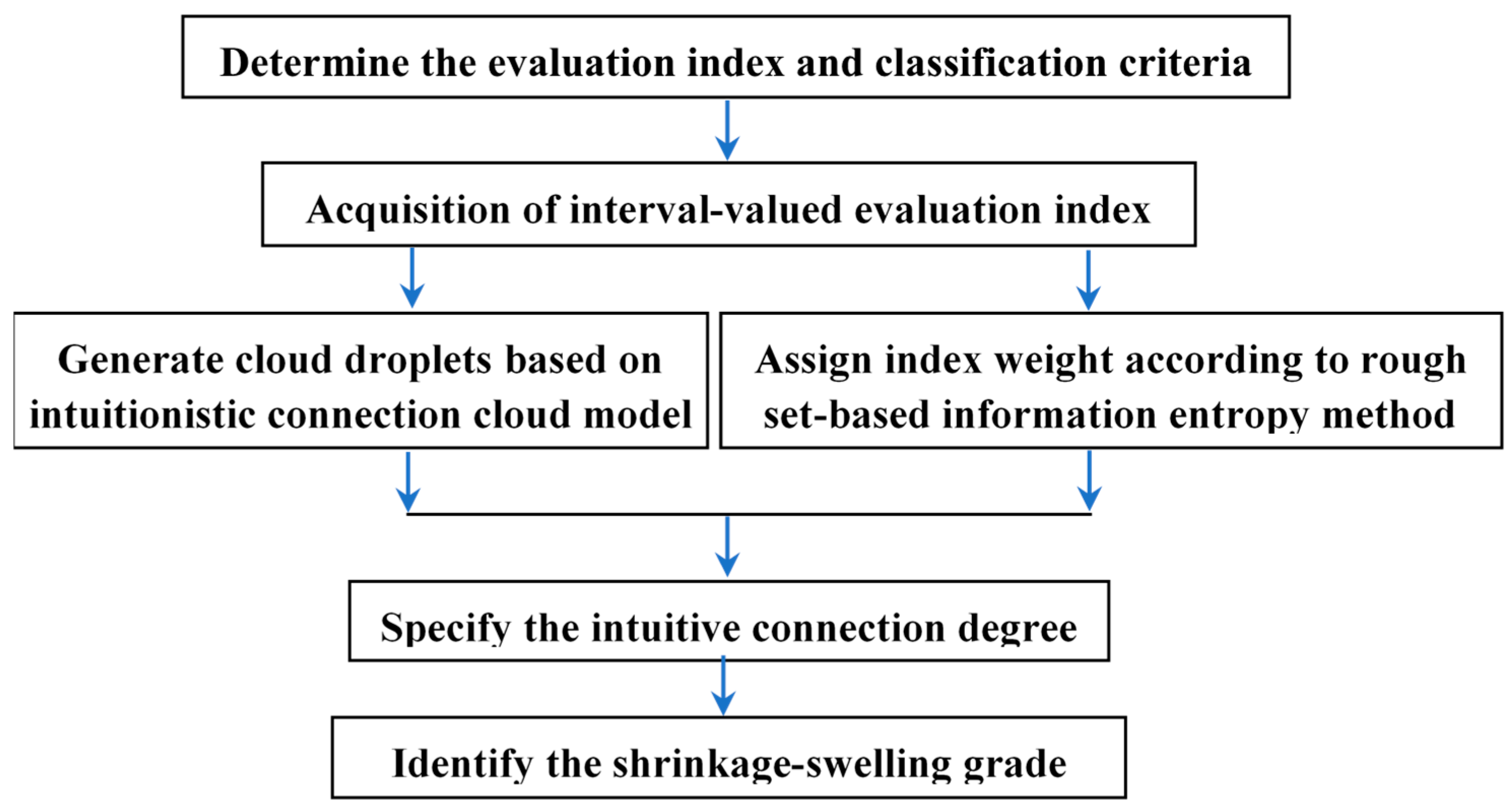
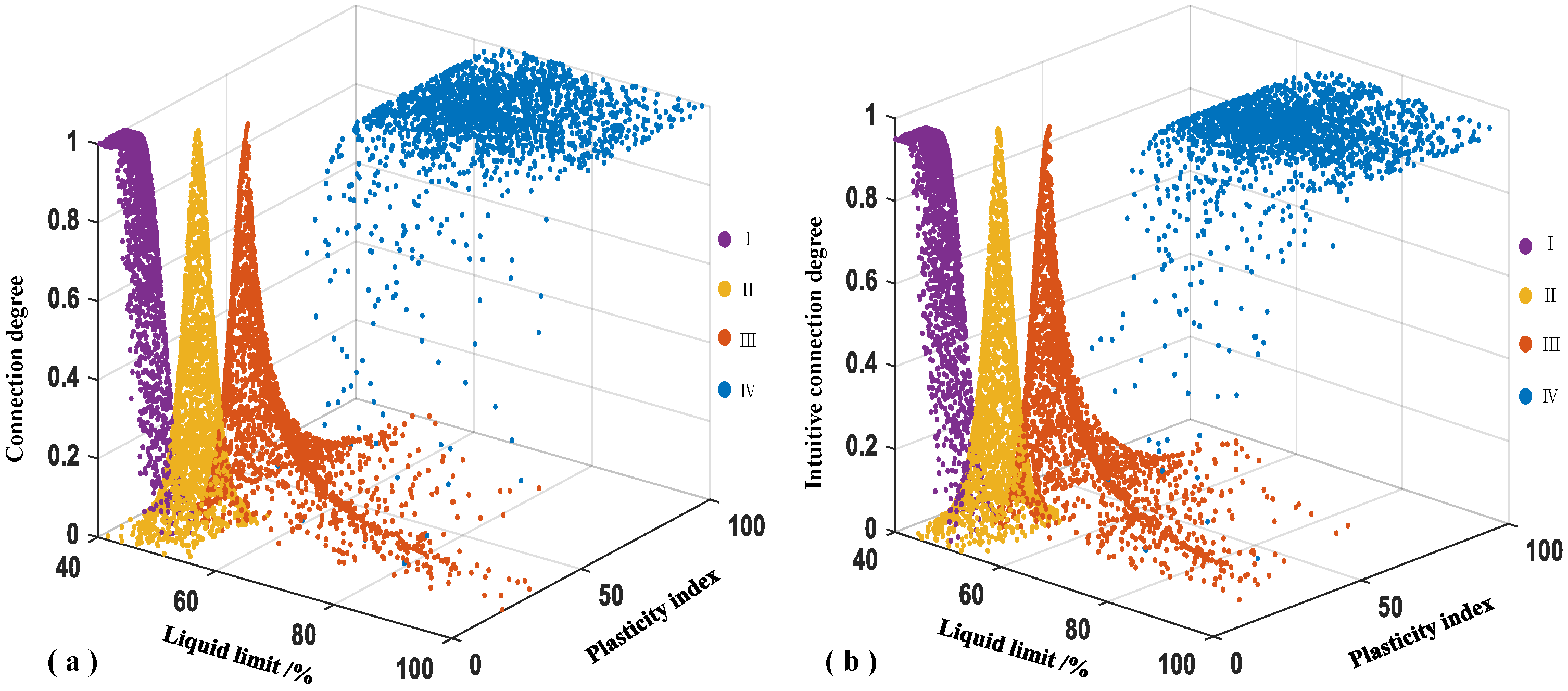
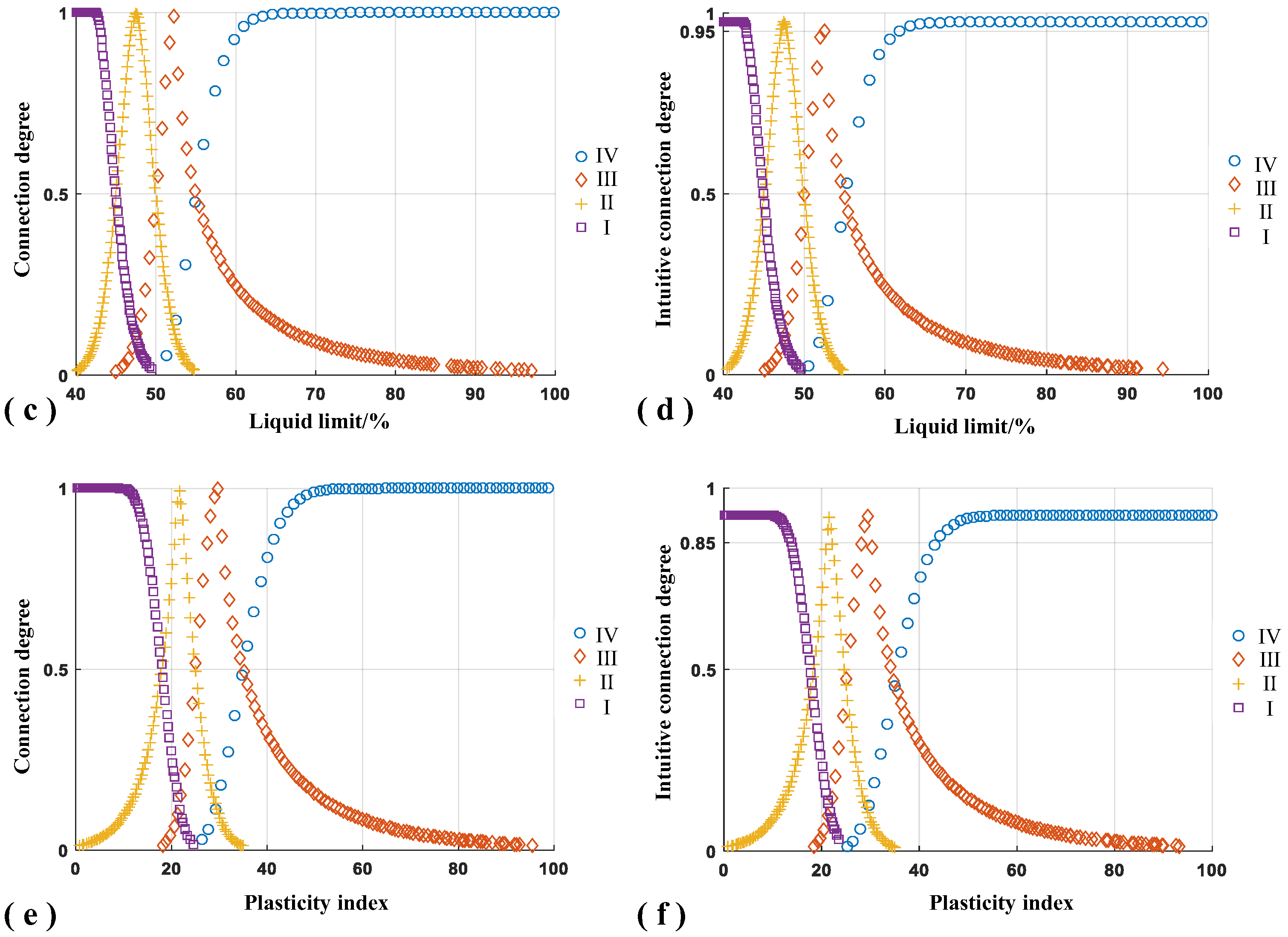
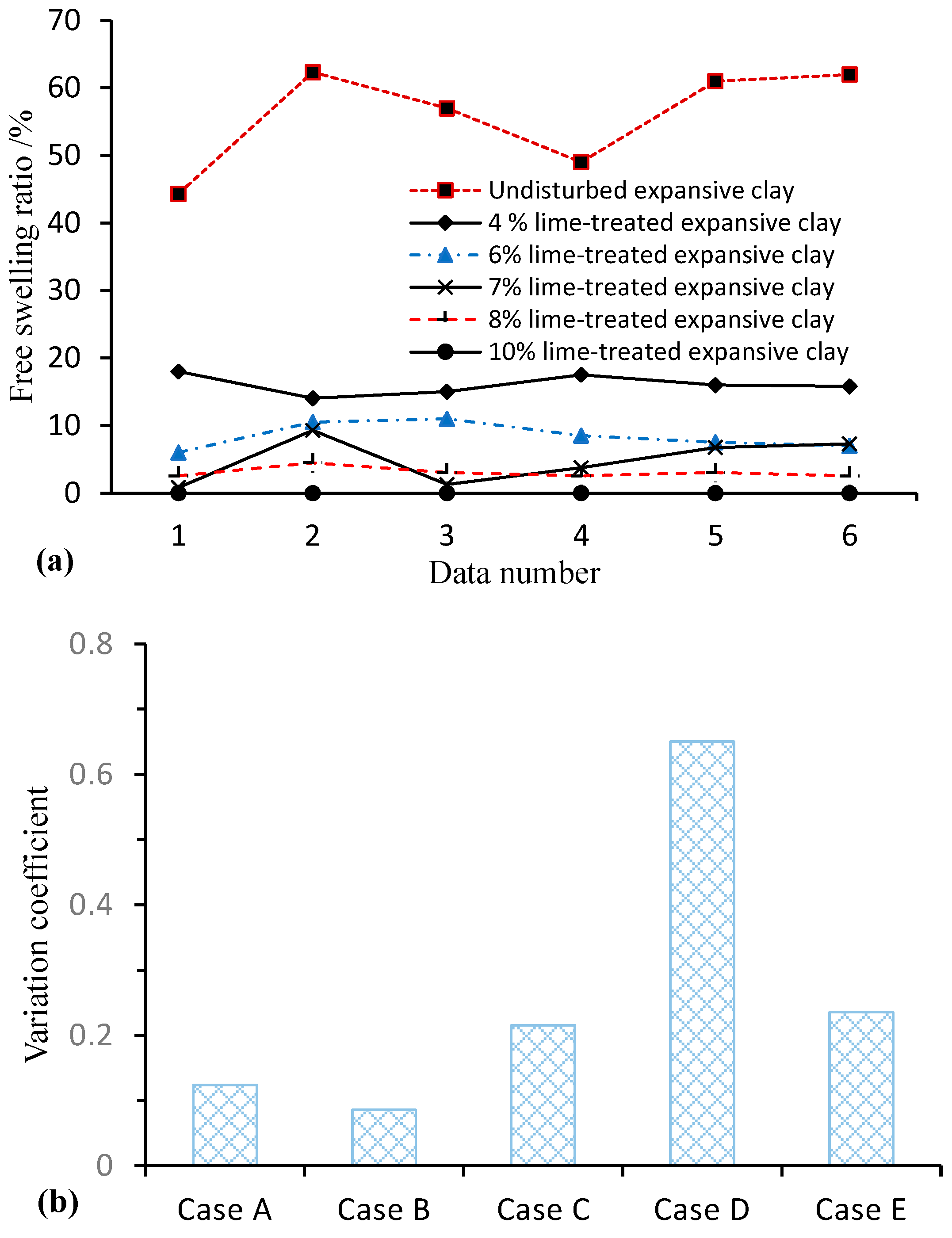

| Grade | Liquid Limit C1/% | Total Shrinkage–Swelling Rate C2/% | Plasticity Index C3 | Natural Water Content C4/% | Free Expansion Rate C5/% |
|---|---|---|---|---|---|
| Extreme High, I | 55~100 | 6~100 | 35~100 | 0~15 | 85~200 |
| High, II | 50~55 | 4~6 | 25~35 | 15~25 | 70~85 |
| Moderate, III | 45~50 | 2~4 | 18~25 | 25~35 | 55~70 |
| Low, IV | 40~45 | −2~2 | 0~18 | 35~100 | 0~55 |
| Case | Soil Type | Liquid Limit C1/% | Total Shrinkage–Swelling Rate C2/% | Plasticity Index C3 | Natural Water Content C4/% | Free Expansion Rate C5/% |
|---|---|---|---|---|---|---|
| A | Untreated expansive clay | [44.7,48.2] | [0.26,0.44] | [23.6,24.8] | [20.4,26.5] | [44.3,62.3] |
| B | 4% lime-treated expansive clay | [45.6,46.7] | [−0.76,−0.33] | [20.3,21.5] | [16.3,22.7] | [14.0,18.0] |
| C | 6% lime-treated expansive clay | [43.2,43.4] | [−0.73,−0.27] | [15.3,16.0] | [16.5,22.5] | [6.0,11.0] |
| D | 7% lime-treated expansive clay | [43.4,50.0] | [−0.15,−0.20] | [15.0,23.0] | [14.0,23.0] | [0.8,9.3] |
| E | 8% lime-treated expansive clay | [43.3,43.7] | [−0.763,−0.33] | [13.5,16.0] | [16.0,22.5] | [2.5,4.5] |
| F | 10% lime-treated expansive clay | [44.3,44.8] | [−1.08,−0.61] | [12.3,16.0] | [16.2,22.8] | [0.0,0.0] |
| Samples | C1/% | C2/% | C3 | C4/% | C5/% |
|---|---|---|---|---|---|
| Undisturbed expansive clay | 0.9976 | 0.8410 | 0.9832 | 0.9346 | 0.9089 |
| 4% lime-treated expansive clay | 0.9933 | 0.7849 | 0.9849 | 0.9078 | 0.9372 |
| 6% lime-treated expansive clay | 0.9988 | 0.7937 | 0.9876 | 0.9271 | 0.8413 |
| 7% lime-treated expansive clay | 0.9563 | 0.9181 | 0.8455 | 0.9000 | 0.5214 |
| 8% lime-treated expansive clay | 0.9975 | 0.8322 | 0.9437 | 0.9275 | 0.8266 |
| 10% lime-treated expansive clay | 0.9968 | 0.8361 | 0.9875 | 0.9057 | 0.6070 |
| Case | Case A | Case B | Case C | Case D | Case E | Case F |
|---|---|---|---|---|---|---|
| Integrated interval | [0.9311,1] | [0.9183,1] | [0.9075,1] | [0.8318,1] | [0.9044,1] | [0.8668,1] |
| Index | Ex | EnL | EnR | He | aL | aR | kL | kR |
|---|---|---|---|---|---|---|---|---|
| C1 | 77.5 | 9.167 | 33.333 | 0.01 | 27.5 | 100 | 9.3217 | 1.2540 |
| C2 | 53.0 | 16.333 | 33.333 | 0.01 | 49.0 | 100 | 44.8877 | 2.4775 |
| C3 | 67.5 | 14.167 | 33.333 | 0.01 | 42.5 | 100 | 6.9729 | 1.6643 |
| C4 | 7.5 | 8.333 | 5.833 | 0.01 | 25.0 | 17.5 | 1.5537 | 2.2077 |
| C5 | 142.5 | 24.167 | 66.667 | 0.01 | 72.5 | 200 | 8.0698 | 1.5006 |
| Case | z(x) | Proposed Model | Connection Cloud Model | Normal Cloud Model [10] | Connection Expectation Method [10] | Chinese National Standards GB/50112 [17] | |||
|---|---|---|---|---|---|---|---|---|---|
| Grade I | Grade II | Grade III | Grade IV | ||||||
| A | 0.0000 | 0.0204 | 0.3543 | 0.0936 | III | IV | III | III | III |
| B | 0.0000 | 0.0002 | 0.0145 | 0.0570 | IV | IV | III | IV | IV |
| C | 0.0000 | 0.0000 | 0.0038 | 0.0947 | IV | IV | IV | IV | IV |
| D | 0.0000 | 0.0000 | 0.0036 | 0.0414 | IV | IV | IV | IV | IV |
| E | 0.0000 | 0.0000 | 0.0020 | 0.0876 | IV | IV | IV | IV | IV |
| F | 0.0000 | 0.0000 | 0.0013 | 0.0888 | IV | IV | IV | IV | IV |
Disclaimer/Publisher’s Note: The statements, opinions and data contained in all publications are solely those of the individual author(s) and contributor(s) and not of MDPI and/or the editor(s). MDPI and/or the editor(s) disclaim responsibility for any injury to people or property resulting from any ideas, methods, instructions or products referred to in the content. |
© 2024 by the authors. Licensee MDPI, Basel, Switzerland. This article is an open access article distributed under the terms and conditions of the Creative Commons Attribution (CC BY) license (https://creativecommons.org/licenses/by/4.0/).
Share and Cite
Wang, M.; Zhang, Y.; Yan, J.; Zhu, Z. Intuitionistic Connection Cloud Model Based on Rough Set for Evaluation of the Shrinkage–Swelling of Untreated and Lime-Treated Expansive Clays. Appl. Sci. 2024, 14, 5430. https://doi.org/10.3390/app14135430
Wang M, Zhang Y, Yan J, Zhu Z. Intuitionistic Connection Cloud Model Based on Rough Set for Evaluation of the Shrinkage–Swelling of Untreated and Lime-Treated Expansive Clays. Applied Sciences. 2024; 14(13):5430. https://doi.org/10.3390/app14135430
Chicago/Turabian StyleWang, Mingwu, Yuhan Zhang, Jiahui Yan, and Zhaohui Zhu. 2024. "Intuitionistic Connection Cloud Model Based on Rough Set for Evaluation of the Shrinkage–Swelling of Untreated and Lime-Treated Expansive Clays" Applied Sciences 14, no. 13: 5430. https://doi.org/10.3390/app14135430
APA StyleWang, M., Zhang, Y., Yan, J., & Zhu, Z. (2024). Intuitionistic Connection Cloud Model Based on Rough Set for Evaluation of the Shrinkage–Swelling of Untreated and Lime-Treated Expansive Clays. Applied Sciences, 14(13), 5430. https://doi.org/10.3390/app14135430






